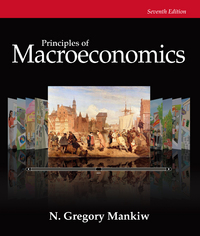Question
Change in Expectations and Number of Consumers Change in Expectations: Expectations refers to the way people think about the future. For example, suppose that a
Change in Expectations and Number of Consumers Change in Expectations:
"Expectations" refers to the way people think about the future. For
example, suppose that a leading maker of audio products announces a technological breakthrough that would allow more music to be recorded on a smaller device at a lower cost than before. Even if the new product might not be available for another year, some consumers might decide to buy fewer recorded products today simply because they want to wait for a better product. Purchasing less at each and every price would cause demand to decline, which is illustrated by a shift of the demand curve to the left.
Of course, expectations can also have a very different effect on market
demand. For example, if there is the prediction that gas will be going up in price in the future (a real thing, as certain nations will pump less oil) you would want to 'stock up' before it actually becomes (more) scarce. The willingness to buy more at each and every price because of expected future shortages would cause demand to increase, which is demonstrated by a shift of the demand curve to the right.
Number of Consumers:
A change in income, tastes, and prices of related products affects individual
demand schedules and curves - and hence the market demand curve, which is the sum of all individual demand curves. It follows, therefore, that an increase in the number of consumers can cause the market demand curve to shift.
To illustrate, suppose Moe, one of Gary's and Bruce's old friends, now
decides to purchase certain items. If we add the number of items that Moe would
demand at each and every possible price to the others, the market demand curve
would shift to the right. This shift would not affect the other individual demand
curves, of course, but, as we shall later see, it will affect the prices that everyone
will pay for the items.
If Gary or Bruce should leave the market the total number of items
would decrease. This shifts the market demand curve to the left. The result
- and the whole point is common sense - if someone is added to the
market the demand goes up (to the right in a demand curve) by pure
volume of buyers, and if someone leaves the market the demand
goes down (to the left in a demand curve) by pure matter of fact
that there are less people buying items.
Task I - Change in Expectations
Objective:
Students will illustrate and then evaluate whether the concept of changing expectations will have a positive or negative effect on demand.
Assignment / Task:
Students will complete one of the following - choosing between illustrating a
positive or negative affect on demand based upon a change in expectation by the
purchasing public.
| Positive: | Negative: |
| Choose a situation that occurs that will drive up the demand of a particular product. | Choose a situation that might occur that will drive down the demand of a particular product. |
| How does the situation / expected event contribute to more people buying the product? | How does the situation / expected event contribute to less people buying the product? |
| What do businesses do to make the product in more of a demanded state? | What do businesses do to make the product retain some of its demand? |
| Is the demand shift permanent or for a short period of time? | Is the demand shift a permanent one or for a short period of time? |
| Is the demand shift based upon a societal / cultural change in expectations or is it an acute change based upon an isolated incident (a trend)? | Is the demand shift based upon a societal / cultural change in expectations or is it an acute change based upon an isolated incident (a trend)? |
Finally - answer the following:
1.)Isthedemandchange(based upon expectations) something that generally is seen as normal in our society - or is it a drastic, unexpected change?
2.)How do the final results relate (in a good or bad way) to our theme (for the course) of (relatively) scarce resources and (seemingly) unlimited wants and needs?
Step by Step Solution
There are 3 Steps involved in it
Step: 1

Get Instant Access to Expert-Tailored Solutions
See step-by-step solutions with expert insights and AI powered tools for academic success
Step: 2

Step: 3

Ace Your Homework with AI
Get the answers you need in no time with our AI-driven, step-by-step assistance
Get Started


